Sergeant Albert E. McQuire
3659648
10th Battalion
Lancashire Fusiliers
1940 - 1945
CONTENTS
Preface
The McQuire family
In the Army
Voyage to India
Preparation for Battle
Situation in the Region
First Battle of the Arakan
Rest and Reorganization
Postscript - Heroes Return
Appendix - Miscellaneous Photographs
References and Acknowledgements
Bernard A. Boden
Gainesville, Virginia
February 2006
PREFACE
During the Second World War Albert (Mac) McQuire served in India
and Burma with the 10th Battalion of the Lancashire Fusiliers. The
battalion participated in the first battle of the Arakan during the
winter of 1942 and 1943. Following the battle it returned to India
where it performed security duties and also served as a training battalion.
As with many of his contemporaries Mac rarely spoke about his war
time experiences. However, a year or two before his death he began
to reminisce to his daughter and her husband who were visiting from
the USA. This prompted them to ask if he would list the places he
had visited in India and Burma and perhaps any experiences he cared
to write about. About a year later on their next visit he handed them
handwritten notes describing some of his experiences.
A short time later, in 1992, Mac died. The notes that he had prepared
along with photographs and a diary kept aboard the troop ship on which
he sailed to India provide the basis for this story. Additional information
has been obtained from various other sources, particularly the web
sites of the Lancashire Fusiliers and the Burma Star Organization.
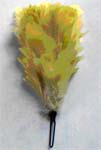
LANCASHIRE FUSILIER HACKLE
THE MCQUIRE FAMILY
For at least three generations during the nineteenth century the McQuires
were glassblowers. It is believed that Mac's great-grandfather, James,
was born in Hull but when son Albert was born in 1865 the family was
living in the Castleford area of West Yorkshire. They moved to Hunslet
where Albert's son Alfred was born in 1887; he married Eva Barnfather
in 1910. Their son Albert was born in Hunslet in 1912 and his brother
Leslie, who also served in World War II participating in the D-Day
landings, in 1922.
Increasing mechanization in the glassblowing industry and a corresponding
reduction in the labour force prompted a move to the resort town of
Blackpool on the Lancashire coast. Alfred and Eva initially ran a
boarding house in Palatine Road near the town centre and later a grocer's
shop in Bela Grove near Revoe School.
Mac worked for the Blackpool Cooperative Society meat department as
a butcher spending all his working life there retiring as manager.
The meat department was a large undertaking that operated numerous
butchers' shops in the Blackpool and Fylde area as well as a farm
where cattle and pigs were raised to supply the shops.
In 1936 Mac married Helen Singleton in Holy Trinity church in South
Shore. Helen was the daughter of Frederick and Jane Singleton who
were market gardeners on Marton Moss. The Singleton family had lived
on the Moss as it was known for generations and for a period in the
mid-nineteenth century Singletons were landlords of the Shovells Inn.
Daughter Avril was born in 1938 followed by a son Stuart born in 1946
who sadly died in infancy.
Mac died in 1992 at the age of eighty in Lytham St. Annes where he
had been living in retirement.
IN THE ARMY
As with many others Mac's career was interrupted by World War II.
His army service began in Airdrie, Scotland, in late 1940. After initial
training with pick shafts instead of rifles and uniforms that didn't
fit Mac became a soldier; unpaid lance corporal and was eventually
posted to the 10th Battalion of the Lancashire Fusiliers. He learned
army ways, never complain to an officer. He did complain about a caterpillar
in his food and was put on a charge resulting in seven days in the
kitchens. Being trained as a butcher he was able to make sure that
the better cuts of meat found their way on to the men's plates rather
than those of the officers.
After about three months the battalion moved to Lowestoft on the South
East coast where it was employed in coastal defence when invasion
by the Germans appeared imminent. The area behind the beaches was
cleared of civilians and much of the time was spent inspecting barbed
wire on the cliffs while German planes let them know of their presence.
Mac became a Bren Gun carrier driver when it was discovered that he
could drive. The carriers were steered by a joy stick; by slowing
one track he found that steering was quite effective. The crew had
an anti-tank rifle, a Bren Gun and rifles but no ammunition.
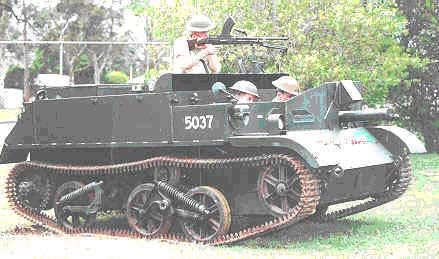
Bren Gun Carrier
Mac's first leave, of seven days, came after six months. In September
1941, the battalion received orders to mobilize for service overseas.
The battalion moved first to the Gloucester area and then to Whitefield,
near Bury where it boarded trains at Bolton Street Railway station
bound for Liverpool docks.
VOYAGE TO INDIA
On reaching Liverpool the battalion embarked on the Argentine liner
SS Reina del Pacifico on 3 December 1941. With a displacement of nearly
18,000 tons she was built in 1931 for the Pacific Steam Navigation
Company and had been used on the Liverpool - Valparaiso route before
its service as a troopship. It was a typical troopship of the time
offering the most basic of accommodation for the 2,500 troops on board;
in peacetime there would have been about nine hundred passengers.
Officer's occupied cabins and had use of the ship's swimming pools
and dining rooms but the rest of the ship had been converted to accommodate
the men.

MV REINA DEL PACIFICO
Now a fully paid Lance Corporal Mac asserted his rights and chose
a space next to the ship's side and contemplated the half inch of
metal between him and the sea. At about eight o' clock the men queued
for hammocks. Mac was in a space with about 130 men and squeezed between
a wall and a table.
Thursday 4 December 1941. Reveille was at 6am, the men having to fight
for one of four wash basins to get washed and shaved. They then rolled
up their hammocks and had breakfast of fat bacon, bread and tea. They
were still at the dockside, what was left of it; just about every
warehouse had been bombed. Tugs came alongside at 7am and pulled the
ship into mid-stream. Mac bought cigarettes in the canteen; fifty
for 1s 6d. Same old fight for hammocks, lifejackets were issued.
The next morning was cold and showery; kipper, bread and tea for breakfast.
With destroyers all around them the ship weighed anchor at 11am and
the ship left Liverpool in a convoy of about twelve ships, the Reina
del Pacifico being the third from last. Shortly after leaving Liverpool
Mac's home town of Blackpool and the tower were clearly visible; what
memories of those so close to him. He wondered what his wife and daughter
were doing and when he would see them again. The first lifeboat practice
was held. Later, the men put on an impromptu concert that Mac enjoyed
very much.
On 6 December the ship arrived off the coast of Scotland and what
appeared to be the River Clyde. The weather was very rough; ships
of all shapes and sizes were all around them. Two submarines glided
past, they were not as big as Mac would have thought. Very good mid
day meal, first good meat since they came on board. Pay day, ten shillings.
It was while the ship was anchored off Greenock in the Clyde that
an event half a world away would have a huge impact on not only those
on board the Reina del Pacifico but the whole world. This of course
was the 7 December attack by the Japanese on Pearl Harbour.
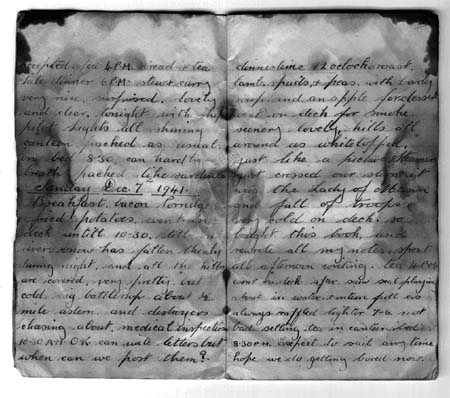
SHIPBOARD DIARY
More ships including battleships joined the convoy which now consisted
of at least forty ships. Although the men were not officially told
of their ultimate destination it was generally believed that they
would be going to Singapore to bolster the garrison there. However,
the rapid advance of the Japanese down the Malayan peninsular would
change those plans.
Monday 8 December; it was a glorious morning and the sea calm. There
is movement now amongst the ships as if they are taking up positions.
Thousands of seagulls swarm around the ship as waste food is pumped
overboard. A huge battleship passed in front of them, a wonderful
sight; another ship brought a barrage balloon and attached it to the
stern. More troop ships were manoeuvring into place. Stewed rabbit
for dinner.
The ship weighed anchor and proceeded to waters off the coast of Northern
Scotland where it joined the rest of the convoy. The threat from U-boats
was a serious danger to shipping as the convoy set sail. Thus the
convoy embarked on a zigzag pattern proceeding west through the Atlantic
channel and into the North Atlantic where it turned south. Rough seas
caused many men to be sick although Mac claimed that he wasn't. The
rough seas, however, did diminish the submarine threat.
Wednesday 10 December; the men had a good breakfast of potatoes and
scrambled eggs but the weather was stormy with waves almost as high
as the ship. Many of the men were ill. It was difficult to stand in
the wind and tempers were getting frayed. An aircraft was seen overhead
and a destroyer fired at it without apparent effect. Word spread around
the ship of the sinking of two British battleships, the Prince of
Wales and Repulse, by Japanese aircraft east of Singapore. It was
this event perhaps more than any other that signalled the demise of
the battleship as a major weapon of war.
The next day one of the ships caught fire which was soon extinguished.
Mac bought a bar of chocolate for a shilling. They were now twelve
hundred miles into their journey. There was news that over one hundred
survivors from the Prince of Wales had landed in Singapore.
The captain of one of the ships, "Empress of Australia",
died and was buried at sea. The ship was now somewhere between the
Azores and the Canary Islands. The weather was becoming tropical,
very warm breeze; lovely one minute, low cloud and pouring rain the
next.
Mac thought of his family, must be about Avril's bed time now. He
saw a Catalina flying overhead, must be getting near land. Another
convoy passed them on the way home; how Mac wished he was on that
one. The weather was now becoming very hot.
On 21 December they could see the coast of Africa. Gunboats and planes
arrived to escort them through the boom defences into their first
port of call which was Freetown in Sierra Leone where they were to
re-fuel and take on supplies. While in the harbour natives came out
in boats to offer bananas, oranges, coconuts, limes, and other fruit
not seen in England since before the war. The men would wrap halfpennies
in silver paper and throw them overboard; the natives expecting silver
shillings would dive for them and as they returned to the surface
demonstrated their knowledge of rude words. At night, the ships were
brightly lit as there was no blackout in effect.
Christmas Eve was extremely hot, very different to what it would be
back in England. Mac thought of his family and of Avril hanging up
her stocking. He thought of his Father who had spent time away from
home while serving in the last war.
Christmas day in West Africa and again it was very hot. There was
a sing song but no other celebrations; at least they had turkey and
Christmas pudding. The ship raised anchor and they said goodbye to
West Africa and soon crossed the equator. Father Neptune came aboard
and they had plenty of laughs. There was a lecture on life in India,
was this where they were going?
Mac had now been away from home for eighteen months, it seemed like
that many years and now they were going to the other side of the world.
He longed for a letter from home, did he really have a wife and baby.
Boxing Day was pay day, 10 shillings. Friday 2 January, 1942 was another
payday; ten shillings. Mac decided to pass time by carving the king's
head out of a halfpenny.

KING'S HEAD CARVED FROM HALFPENNY
The ship rounded the Cape of Good Hope with Table Mountain clearly
in view. New Years day was cold and windy, but it got very hot in
the sunshine. There was a wonderful sunset and the convoy sailed in
bright moonlight. Mac wrote a letter to Helen and Avril.
Prior to reaching Durban they practiced using the Bofors guns. The
ship arrived in Durban on 8 January 1942 where they were issued with
tropical kit; sun helmets, three-quarter length shorts, thick socks,
boots and puttees, all odd sizes. Approaching Durban Mac thought the
docks and city appeared very modern with skyscrapers, very English
in parts and American in others.
That evening and the following days the troops were allowed shore
leave. They were welcomed by the residents and they found a sharp
contrast to the England that they had left behind them, no rationing,
and there were all kinds of English chocolates. Some of the troops
spoiled themselves, drinking and behaving like lunatics. In some canteens
the food was free; in others he could get two eggs, two rashers of
bacon, sausage and chips, fruit salad, ice cream, tea bread and butter
all for ninepence. Mac was able to send a cable home which cost him
2s 6d.
They were about twelve miles from Durban and travelled in by train
each day. Mac thought he would like to settle there as there seemed
to be plenty of opportunity; Helen would love it with native boys
to do all her work. It seemed that white people bossed the natives
and lived like lords.
Unfortunately the brief respite in Durban ended when the ship raised
anchor on 13 January. About 200 miles out one of the liners stopped
to pick up survivors from a sunken ship, a harsh reminder of the real
world after the enjoyable days in Durban. From Durban the convoy sailed
north without incident before heading east across the Indian Ocean.
Saturday 17 January; the leading cruiser in the convoy, the Dorchester,
sighted a tanker and gave chase. The last they saw of the tanker was
the stern sinking beneath the sea. It appeared that it had been scuttled.
Mac played deck horse racing and lost two shillings.
The next day was extremely hot; Mac was breaking out in boils with
a very painful one under the arm. He was sick, tired and fed up, he
longed for a letter from Helen. During this part of the voyage many
men had been suffering from the extreme heat including Mac who had
developed several abscesses in addition to the boils. One of the ships
stopped to bury someone who had died, the fifth that Mac knew of.
The ship arrived in the Gulf of Aden and dropped anchor. At this time,
the Japanese army was advancing down the Malayan Peninsular towards
Singapore now in imminent danger of being overrun. It was speculated
that the original plan to proceed to the Far East had been under review
because of the potential loss of Singapore. After several days at
anchor the ship left the convoy on 21 January 1942 and headed alone
for Bombay, India. Money was changed for rupees.
Land was sighted on the morning of 27 January and the ship docked
in Bombay harbor. Bum boats come alongside selling fruit, knives,
wallets and other items. Just opposite was the Taj Mahal hotel and
next to it the Gateway of India a monument built to commemorate the
visit of King George V and Queen Mary in 1911.
The next day the battalion disembarked and immediately boarded
trains for Quetta in Northwest India close to the border with Afghanistan.
The trains stopped in Delhi for a while before continuing the journey
to Quetta traveling through awe inspiring mountains. After a brief
stop in Sibi where they were besieged by beggars they arrived in Quetta
on the last day of January, 1942. The 10th Battalion was met by the
band of the 1st Battalion and they marched about three miles to the
camp. The 1st Battalion had been stationed in Quetta since 1938. Mac
was now troubled by sciatica as well as the abscesses.
Quetta consisted of mud built shacks and the country was very
dry with little vegetation. The battalion inherited the 1st Battalions
vehicles, it seemed to Mac that they were all of pre 1918 vintage;
he could not believe that the British Army in India was so badly equipped.
The camp was new; there was not a tree or blade of grass in sight.
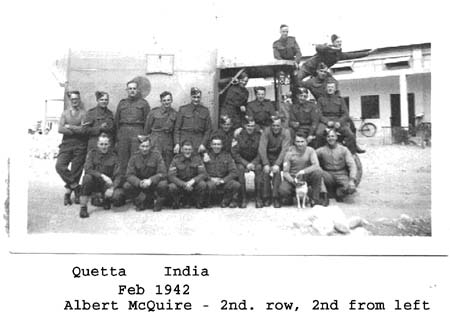
They were now wearing thick clothes, the food was moderate and
there were few amusements. After settling into some kind of routine
the men were marched about sixty miles north to the Afghanistan border
for training in mountain warfare. Tents were erected on the edge of
a desert near the mountains, the tribesmen coming to stare and show
their prowess in shooting, they had Russian rifles and also long native
guns firing home made bullets, they were very good at targets in the
hills. When on guard duty Mac wore a big fur coat which was full of
lice and he was warned that the Afghans liked to creep up and cut
ones throat.
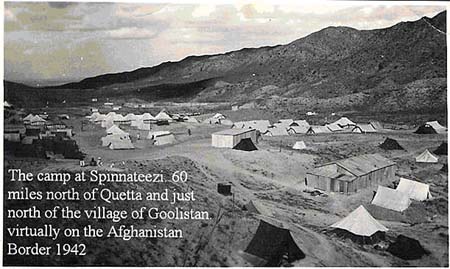
Three months after returning to Quetta they once again boarded
trains and after seven days of going to what seemed every town in
India they arrived in Dacca in what is now Bangladesh. They continued
on to Comilla where they took a steamer south and disembarked the
carriers.
The fusiliers had been transported from the mountainous regions of
Northwestern India where the weather was "bracing" by day
and "bloody freezing" by night to the hot tropical jungles
of East Bengal. The contrast in weather and topography could not have
been greater. They soon discovered that June in East Bengal was not
a very pleasant place to be.
The 10th Battalion now joined the 123rd Infantry Brigade which
in turn was part of the 14th Indian Infantry Division commanded by
Major General W. L. Lloyd. The 123rd brigade consisted of the 10th
Battalion Lancashire Fusiliers, and two Indian Army units, the 8th
Battalion of the 8th Baluch Regiment and the 1st Battalion of the
15th Punjab Regiment. The division also included the 47th Indian Infantry
Brigade. The 14th Division was part of what was then known as the
Eastern Army that later became the XIVth. Army.
While in the Chittagong area the troops were given a period of
training in jungle warfare of which they knew little whereas the Japanese
had had been training intensively in its skills and technicalities
for some time. The consequence was that they that they had gained
a reputation for invincibility which was rather depressing for morale.
REGIONAL SITUATION
Following the attack on Pearl Harbour the situation in the Far
East was becoming increasingly desperate. The Japanese occupied Hong
Kong on Christmas Day, 1941, and Singapore fell on 15 February. Mandalay
and Rangoon were soon overrun and by the middle of May the British
forces had been pushed back all the way to the Indian border. Following
the retreat, there was considerable pressure from London to mount
an early offensive and General Wavell, Commander in Chief India, was
in sympathy with this aim as he believed that unless something was
done the morale of the British and Indian troops would sink to the
point where future operations would be seriously jeopardized. He was
fully aware that the British reinforcements arriving in the area consisted
of wartime conscripts whose only wish, understandably, was to get
back home and do as little fighting as possible. He also knew that
political unrest in India could eventually affect the Indian troops.
The only way to motivate such a mixed force was to try and beat
the Japanese in an area where there was a good chance of success.
The original plan was to capture the port of Akyab but due to lack
of amphibious resources a more modest plan to advance into the Arakan
was adopted; the formation selected for the operation was the newly
formed and inexperienced 14th Division. It was in this situation in
September 1942 that two brigades of the division, which included the
Lancashire Fusiliers, were ordered to advance from their positions
behind Chittagong to Cox's Bazaar where a halt was called to build
up resources and establish supply depots before crossing the Burmese
border into the Arakan.
FIRST BATTLE OF THE ARAKAN
The The Arakan is situated on the Mayu Peninsula which is shaped like
a "V" with its point facing southwards. At this point is
the port of Akyab, the original objective of the offensive. The peninsula
is about ninety miles long by about twenty wide at its northern (India)
end. Down its centre runs the Arakan Yoma, a razor sharp ridge from
one to two thousand feet high, precipitous but jungle covered. The
narrow coastal strip, which is intensely malarial, is some four miles
in width and intersected by tidal waterways (known as chaungs), planted
with paddy, and studded with villages of teak houses, thatched huts
and clumps of trees. Beyond the Arakan Yoma lies a valley through
which flows the River Mayu. The small town of Buthidaung is built
on its banks. Such a terrain would afford, at frequent intervals,
ideal positions for defence, and gravely hamper the deployment of
an attacking force.

NORTHWESTERN BURMA AND THE ARAKAN
As will be seen in the map, the northern part of the Arakan Yoma
is crossed by two tracks, one running through the Goppe Pass between
Bawli Bazar and Goppe Bazar and the other through Ngakyedauk Pass
(anglicized by the troops early in the campaign to "Okeydoke
Pass"). The only all weather road, a disused railway built in
the 1890's, passes through two tunnels linking Maungdaw and Buthidaung.
When the brigades eventually began to move forward it would have been
expected that the monsoon would have ended, sadly during the winter
of 1942/1943 the monsoon extended well into November and December.
Thirteen inches of rain fell in November.

ROUTE TAKEN BY THE LANCASHIRE FUSILIERS
The 10th Battalion left Cox's Bazar at 1815 hours on the second
day of November 1942 and marched to Ukhia just north of the Burmese
border. Monsoon rains were making conditions virtually unbearable.
The men were knee deep in mud traveling through difficult terrain,
and the sheer physical strain being placed on the fittest and strongest
of men was bearing down hard. At one point, Fusilier Jimmy Ince fell
face down in the mud and just lay there. He was helped by his comrades
who had to clear the mud and filth from his nose and mouth. During
the night, Jimmy Ince died, one of the many who would die of malaria;
his final resting place is the British War Cemetery in Chittagong.
From Ukhia the battalion marched to Nowapara where an advance
patrol under the command of Lieutenant Foster was sent out to reconnoiter
the area around Goppe Bazar and Taung Bazar well inside the Burmese
frontier. Here they encountered the Japanese for the first time and
laid a successful ambush. The patrol returned intact. Sampans were
often used as the most effective means of transportation and were
used by advance parties as they moved from Nawapara to Bawli Bazar.
The battalion was unopposed as it entered Buthidaung on 17 December.

TUNNEL NEAR BUTHIDAUNG
The division now moved on a two brigade front, with 47th Brigade advancing
down the coast toward the Mayu Peninsular, while 123rd Brigade, including
the Lancashire Fusiliers, was directed on Rathedaung, east of the
Mayu river estuary. The battalion marched to Taungmaw arriving on
27 December. During a crossing of the river at Kindaung a sampan accident
cost the lives of two Fusiliers. Patrols pushing forward toward Rathedaung
initially met with no opposition but a detachment trying to occupy
a riverside jetty met with overwhelming enemy fire.
By 28 December the battalion was at Htizwe, on the road running south
from Buthidaung to Rathedaung. The battalion marched to Thaungdara
Chaung where an attack was to be launched on Rathedaung. They were
met with very heavy fire and forced to withdraw. The column retired
the next day to the area of its original starting point at Thaungdara
and took up defensive positions around the village behind Thaungdara
Chaung.
On 29 December another advance on Rathedaung commenced and after meeting
no opposition until later in the day when units were held down by
mortar and machine gun fire. Battalion headquarters established itself
in the area and attacks were made on enemy positions but the attackers
were forced to withdraw in the face of heavy fire.
There was now a delay of some ten days due to administrative difficulties.
It may be that the urgency of the situation was not fully realized
and that troops should have been pushed forward to take advantage
of the situation. But the brigades were operating at the end of a
very tenuous line of communications over 150 miles from a railhead
and the weather was unfavorable, heavy rain making the road almost
impassable. The delay allowed the Japanese to construct strong defense
works covering Rathedaung, and also in the Donbaik area near the tip
of the peninsular.
During this time defensive positions were established around villages
and other features. The battalion formed up for an attack on enemy
positions north of Rathedaung. On 9 January after the softening up
of suspected enemy strong points by the RAF and Number 3 Mountain
Battery the battalion advanced and heavy fighting took place in the
area of Thaungdaura during which a number of casualties were sustained.
Following heavy fighting on 18/19 January action was confined to reconnaissance
and patrolling for the remainder of the month.
On 3 February the battalion formed up for an attack on a feature
known as West Hill. Thia attack was to the right flank of a brigade
attack on enemy positions north of Rathedaung with 1/15 Punjabis on
the left, 8/6 Rajputana Rifles in the centre and the Lancashire Fusiliers
on the right. The southern slopes of West Hill were captured without
opposition; however, there was heavy opposition on the northern slopes.
An attack was pressed home all day but no appreciable advance had
been made and the enemy appeared to be as strong as ever. It was now
obvious that to have withstood the heavy artillery concentrations
the enemy must have had enormously strong positions, invulnerable
to the gun fire. The battalion reformed and took up defensive positions
with brigade reserve at Kanbyin.
By now the Japanese had decided that they had no intention of losing
Rathedaung to the Allies, and began taking a more aggressive attitude.
It was clear that they had received considerable reinforcements. They
began with a counter offensive directed, in the first instance, against
the eastern flank of the British forces on the Kaladan River. The
offensive was at first successful and the Japanese followed it up
by crossing the hills and menacing the communications of 123rd Brigade.
At the same time they carried out a series of diversionary attacks
against the brigade's southern flank north of Rathedaung.
For the period 9 February through 3 March activities were again limited
to reconnaissance and patrolling. The enemy shelled Battalion Headquarters
in the area of Hkanaunggyi, about sixty shells were fired but caused
no casualties. The enemy attacked and overran positions on two of
the hill features inflicting heavy casualties on the defending platoon.
The attack was carried out with great noise, the enemy screaming and
shouting and at intervals calling out "withdraw, withdraw".
On 7 March, No. 4 platoon, a carrier platoon, under Lieutenant
Percy Weiner was ordered to proceed to Hkanaunggyi. The platoon counterattacked
surprising the enemy who hastily withdrew and the platoon took up
defensive positions around Battalion HQ area. The enemy captured two
hill areas successfully cutting the line of communication with the
only means of communication being the carriers which meant running
a gauntlet of fire and exposing them to risks they could ill afford
to take. Nevertheless, during the day No. 4 platoon did excellent
work in keeping the forward companies supplied with rations and information.
Many separate actions took place during the day.
The following day the enemy continued to shell any movement they
observed while snipers were also active. On 9 March, orders were received
from brigade headquarters to withdraw on Thaungdaura. During the day
Lt. Weiners No. 4 platoon was involved in transporting ammunition
and other supplies to the rear. From his positions the enemy was able
to cover the Hkanaunggyi - Thaungdara road for some considerable distance
and made full use of this, shelling the carriers as they proceeded
to and from Thaungdara. In spite of this they accounted for only one
carrier, knocked out by an anti tank rifle. Enemy snipers were again
active.
123rd Brigade was relieved by 55th Brigade on 13 March, however,
the 10th Battalion of the Lancashire Fusiliers and the 1/15 Punjabis
were ordered to remain in position and attached to 55th Brigade. Headquarters
Company was attacked on 15 March in Thaungdara village but the defence
held and the enemy was driven off. However, the enemy had got a foothold
north of Thaungdara Chaung and in the mangroves on the banks of the
Mayu River that enabled him to cover the Thaungdara - Htizwe road
with heavy machine guns thus cutting a main line of communication.
Although the enemy's offensive had been unsuccessful the general situation
was deteriorating for the British troops, for apart from the brigade
constantly being reduced in numbers, as well as being very tired,
the enemy had sent a further force north along the east flank thus
cutting the line of communication to Buthidaung in the Taungmaw area.
By this time the greater part of the front had been taken over by
26th Indian Division and 123rd Brigade was withdrawn still further
north to rest and reorganize.
At the beginning of May, the survivors of the brigade were back behind
the Maungdaw-Buthidaung line and the Japanese 55th Division was pressing
them hard. General Slim, who in April had been appointed to command
all troops in the area, had a hope of salvaging something and sent
down two fresh brigades but once he realized the condition of the
men of the 14th Division he made plans for a further gradual withdrawal.
On 3 May the battalion was attacked in their positions and the Japanese
drove through and across the tunnels road and there was no practical
alternative to a hasty withdrawal to a new line curving up from Nhili
to Bawli Bazar and Goppe Bazar, then down across the Mayu. There the
Japanese were content to leave the British almost undisturbed.
The situation did not improve. The Japanese continued infiltration
tactics, and the Allied troops, weakened by exertion, disease and
casualties, were exhausted and gradually forced back over what had
been their victorious battlefields of six months before until, Maungdaw
and Buthidaung again lost to the enemy, they finished in the positions
from which they had started. The Arakan campaign had virtually overwhelmed
the medical services with battle casualties and sickness and at the
time little attention could be paid to the alarming number of psychiatric
cases. The Command Psychiatrist wrote "the whole of the 14th
Indian Division was for all intents and purposes a psychiatric casualty".
The formation was never returned to front line duty and spent the
rest of the war in India performing security duties as well as acting
as a training division.
The campaign had been fought under the hardships of climate and terrain
combined with the normal hardships of war. Far worse than the number
of casualties caused by enemy action was the number caused by sickness
and disease, malaria being a constant menace. At one time the 10th
Battalion was losing as many as forty men a day from this cause alone.
It was as hard and as miserable a campaign as British troops have
ever been called upon to fight. The first Arakan campaign had been
a failure, the chief reason being as General Wavell said "I set
a small part of the Army a task beyond their training and capacity".
He also said "In the initial advance the troops of the 14th Division
fought boldly and well. It was only in the latter stages of the fighting,
after several months of continuous engagement in an unhealthy climate
and under the discouragement of failure was there any deterioration
in the endurance and fighting capacity of the troops."
MAC'S PERSONAL MEMORIES FRM THE ARAKAN
Shortly before his death in 1992 Mac recorded some reminiscences
from the Arakan and the following is based on his notes.
From Cox's Bazar the brigade moved south across the border with
Burma by stages along the coast road. The forward Japanese were somewhere
ahead and the carriers being tracked vehicles were able to proceed
along this road to scout.
The leading carrier in his group was hit and the crew killed. The
remaining two carriers went back to report as instructed because they
only had light guns. The battalion advanced and engaged with mortar
fire and after making little headway returned to Cox's Bazar. The
battalion re-equipped and employed different tactics as the battalion
advanced to Ukhia and Nawapari, then on to Bawli Bazar.
There were times when the carriers could not be used, the only means
of transportation being sampan or canoe. On one occasion Mac was put
in charge of about fifty coolies carrying supplies along tracks in
the jungle. The coolies began at a jog trot with Mac in the lead but
he was soon exhausted and ended up at the rear. After crossing a river
they reached a forward base; Mac was informed that they had done well
in losing only a quarter of the supplies. The next day they had to
return to base but he only knew the approximate direction to the river.
It was hot and they had little food but after various mishaps they
found the river and followed it eventually coming to a native village.
There they persuaded boatmen to take them downstream. They were promised
payment but according to Mac they are probably still waiting.
At other times the men had to slash their way through the undergrowth
using large knives; the many thorns making it almost impossible to
advance. Monkeys enjoyed watching them but so did the Japanese who
used to call out at night shouting "Come on Johnny" or "Give
up Johnny". After a while they returned for the carriers and
followed the railway, the tracks having been removed. They camped
at the end of a tunnel and suddenly a herd of elephants came charging
out, it was fortunate that they were in the carriers at the time.
The carriers were sent out to scout and report any activity ahead.
One morning it was beautiful and there was a pool nearby and Mac,
being a sergeant, went first to wash and shave at the pool and also
wash his shirt. On returning to the carrier several trucks approached
when the first one went up in a huge explosion about one hundred yards
away. The Japanese had apparently been expecting the trucks and there
were many more explosions.
Mac realized that the Japanese had been watching him all the time
but they were waiting for bigger game. Trees were sprayed with Bren
Gun fire and some bodies fell down. Mac sent a man to the rear for
assistance but he only got about a hundred yards so another was sent.
He got through and an officer came up on a motor cycle; as he climbed
on to a carrier he fell; shot through the head.
The final words in Mac's notes of his war time experiences are; "towards
the end of the campaign the old 10th Battalion was badly decimated
and now composed of army, RAF and even sailors; I had lost sight of
my old mates and my carrier".
It is difficult to relate the incidents described by Mac to specific
dates and events in the overall campaign; however, there are two instances
where it seems that a connection can be made.
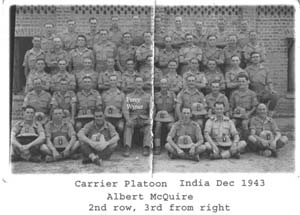
The official war diaries for March 1943 mention carrier activity and
Mac was of course a carrier driver. The entries for 7 March 1943 refer
to No. 4 platoon commanded by Lieutenant Weiner and from the descriptions
it appears to have been a carrier platoon. In a photograph, shown
above, of a carrier platoon the officer at the center of the front
row has since been identified as Percy Weiner, Mac is on the second
row. While there is no certainty that Mac was present during the actions
on 7 March it seems likely that he was.
The message shown below was found amongst Mac's possessions and contained
an urgent request for mortar ammo and petrol indicating that the bearer
would bring back as much as he could. As these items could not be
carried by an individual the bearer must have had transport. As Mac
was a Bren Gun carrier driver and the carriers were the only mechanized
transport available it seems likely that Mac was the bearer of this
message. The reverse side of the message includes a comment "no
contact with Buthi" which obviously refers to Buthidaung. In
his book about the Lancashire Fusiliers, Major John Hallam relates
an incident where a Lieutenant Foster, see the description of the
battle above, laid an ambush for the enemy. As can be seen on the
message the originators name is Foster.
 .
.
MESSAGE REQUESTING URGENT SUPPLIES
REST AND REORGANIZATION
Following it's withdrawal from the Arakan, the battalion arrived in
Ranchi on 14 May 1943 for rest and reorganization. During this time
Mac was a patient at the British Military Hospital in Meerut which
is about forty miles Northeast of Delhi. Whether his stay at the hospital
was because of wounds or for treatment of malaria, symptoms of which
appeared frequently in the years after the war, or other sickness
is not known. He also contracted Dengi Fever and various skin diseases.

HOSPITAL PATIENTS MEERUT, INDIA
Shortly after arriving at Ranchi leave parties departed, one consisting
of 220 men going to Darjeeling the other of 93 men to Ranikhet. It
is interesting to reflect on the fact that the leave parties consisted
of just over 300 men. Is it possible that out of the original battalion
strength of about 900 that the ones making up the leave parties were
the only ones fit to travel? The battalion left Ranchi for Fyzabad
on 14 July where it was employed on internal security duties. From
Fyzabad the battalion moved to Lucknow where, in December, it was
joined by the 1st Battalion, back from its participation in the second
Chindit expedition.
In February 1945 the 10th Battalion returned to Ranchi and became
a training battalion of the British Reinforcement Training Group.
The 10th battalion stayed at Ranchi until the end of the war when
it began returning to the United Kingdom in different drafts in late
July and early August. After arriving in Liverpool the troops were
immediately transported to Hunstanton on the East Coast where they
were billeted in private houses while awaiting demobilization. The
10th Battalion was finally disbanded on 31 October 1945. This was
five years after Mac had left home and family to join the army.
POSTSCRIPT
In November 2005 a survivor of the 10th Battalion, Bill Dalton, made
an emotional return to Burma and the Arakan. The journey was made
possible by the "Heroes Return" program which assists veterans
to return to the area in which they saw active service during World
War II. Bill was one of the men who helped Jimmy Ince, mentioned in
the description of the battle of the Arakan. In the photo from the
Illustrated London News shown in Appendix A, Bill is to the right
of the soldier reading the newspaper.
Appendix B shows the jetty at Rathedaung and the entrance to one of
the tunnels between Buthidaung and Maungdaw as they are in 2005, both
areas of heavy fighting.
APPENDIX A
MISCELLANEOUS PHOTOGRAPHS
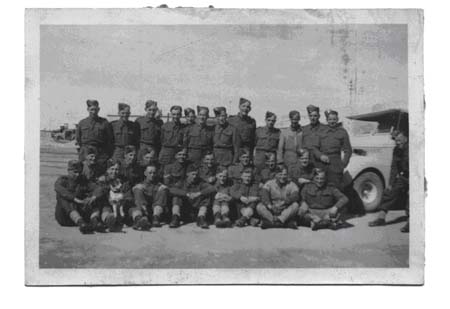
MT PLATOON, QUETTA, INDIA FEBRUARY 1942

THE ILLUSTRATED LONDON NEWS MARCH 27 1943

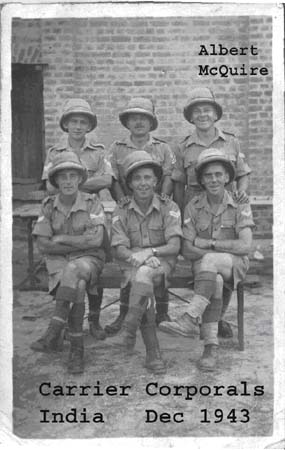
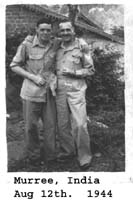
EXTRACT FROM WAR DIARY
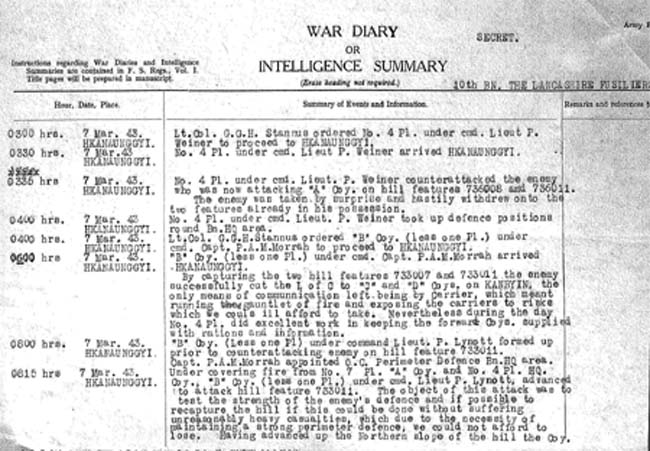

APPENDIX B
HEROES RETURN - 2005
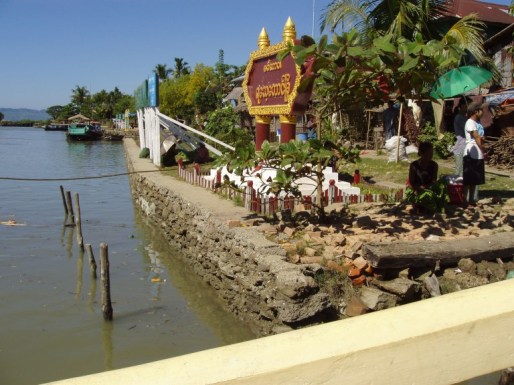
JETTY AT RATHEDAUNG
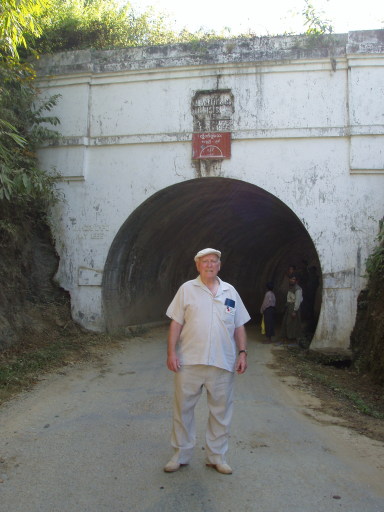
BILL DALTON AT ONE OF THE TUNNELS
ACKNOWLEDGEMENTS AND REFERENCES
The History of the Lancashire Fusiliers 1939 - 45 by John Hallam
The Bill Dalton Story Geoff Pycroft
XX Lancashire Fusiliers web site www.lancs-fusiliers.co.uk
FEPOW web site www.fepow-community.org.uk
The Burma Star web site www.burmastar.org.uk
The Unforgettable Army, Michael Hickey Slim's XIVth Army in Burma
War Diaries, 1942 National Archives Ref. WO172/872 November and December
10th Battalion Lancashire Fusiliers
War Diaries, 1943 National Archives Ref. WO172/2526 January, February,
March 10th Battalion Lancashire Fusiliers

